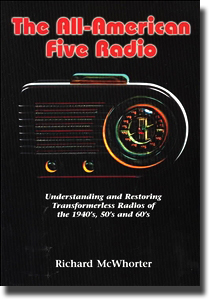 The All-American Five Radio by Richard McWhorter. 2003.
The All-American Five Radio by Richard McWhorter. 2003.
This is a short book (96 pages officially—really 92) but it's no-nonsense. McWhorter chooses a 1950 RCA 9X561, an early All American Five (AA5), and discusses how and why it works. As with Marcus & Levy below, he breaks down the radio into discrete stages and discusses each separately. Unlike Marcus & Levy, the entire focus is on this single radio—with the idea that if you understand this one, you can figure out the minor variations in other AA5s.
The book assumes no prior knowledge of electronics, so a chunk of the book at the beginning is devoted to the very basics: what is voltage, current, resistance, Ohm's law, how a capacitor works, and so on. Obviously at 92 pages you're not going to get a thorough education, but it's enough to get you by. The idea is teach someone enough to fix this radio (if it isn't too far gone) without having to go through a full radio course. From that respect it's good; it's simply written and it's heavily illustrated. But its brevity means there's a lot of stuff left out: actual "repair" info is thin, and common fixes like what to do about a slipping dial cord or how to align the receiver aren't mentioned at all. The book is mainly about understanding how it works, with a modicum of repair info added.
I'm luke-warm on it. It's good for what it is, but I would have like to have seen a lot more in the repair and restoration department. I think his book The Vacuum Tube Short Wave Radio is far better.
McWhorter also has a YouTube channel with videos about radios, repair and related subjects.
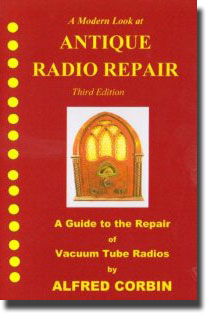 (A Modern Look at) Antique Radio Repair by Alfred Corbin. 3rd edition (2010)
(A Modern Look at) Antique Radio Repair by Alfred Corbin. 3rd edition (2010)
This is the most recent repair text that I've seen. It also comes spiral-bound so it lies flat on a table or bench, which is a godsend if you're reading while you're working on something. My only quibble is that it's the size of a regular book, which makes some of the schematic diagrams small and hard to read. Compare this to the text itself, which is larger-than-average and easy to read; I would have loved this before I got my bifocals.
Corbin's doing what McWhorter tried to do in The AA5 except that he's taking a broader look, whereas McWhorter studies one single radio. So this book is really much closer to Marcus & Levy's Elements of Radio Servicing, except that this is written for a modern audience. Marcus & Levy wrote in an era when these radios were current or just passably old; Corbin's writing about antiques. It's the difference between a repair manual for a Ford Model T written in 1930 vs. 2010. Things change.
The upside is that it's very well written and decently illustrated. At almost 300 pages, it gets into a lot of detail that McWhorter's AA5 didn't have room or time for. All the important stuff is there: common types of radios, alignment, recapping, all about tubes, components, antennas, and so on.
The downside is that it's organized in an odd way. It starts with "a little history" and then goes to "first aid for an old radio." Then it's back to types of radios, then back to earlier types (regens and TRFs). Then there's a bit on automobile radios (something you don't see in most books, so it's worth mentioning here). Then FM. Then we get to fundamentals of servicing, alignment and recapping. Then a discussion of tubes, followed by a rundown of component types (resistors, caps, coils, etc.) Then onto common failure modes, etc.
I read a critical review on Amazon that the book seems to jump all over, and I agree. If you have some background already, you can follow it. But if you were coming in from square one, knowing almost nothing about electronics, the book is going to be a bit confusing. It would be the sort of text you'd have to read through entirely first, then things would make more sense on the second run-through.
Also, like McWhorter, Marcus & Levy, and most other antique radio repair books, it's aimed at the Superheterodyne mass-manufactured radio. Granted, that's 99% of radios out there by numbers. But it means that if you're interested in TRFs (popular in the 1920s), or that Hammarlund boat anchor, or even a Zenith Transoceanic, this is just a starting point and you'll have to go elsewhere for more info.
But that, like the schematic sizes, are quibbles. I genuinely like this book and I learned a lot from it. Very much worth reading.
As I type this, there's a 4th edition out now. I have not seen it.
Basic Radio Course by John T. Frye. 2nd edition (1961)
Another in the Gernsback Library (see Rapid Radio Repair below). Like other books I've reviewed here, it's an introduction into tube-era radio electronics. There's a small section on transistors but the bulk is written for tubes. It's readable and nicely done. I think Elements of Radio (below) is better, but I enjoyed this one anyway.
The only thing that really breaks this out of the pack is the author's occasional attempts at humor, so that the text isn't completely dry and dull. The humor is sometimes a bit corny and folksy, and it definitely dates the book. This is how the author begins the section on inductance:
Have you sat in a hotel lobby where all was quiet until a cute blonde got up from where she had been sitting unnoticed behind a potted palm and glided across the floor? If you have, you may have noticed—if you were not too busy watching the blonde—that there was something magnetic about the girl in motion that seemed to exert a magnetic effect on every masculine head in the lobby.
Still in all, I found the book engaging and well written, and I recommend it.
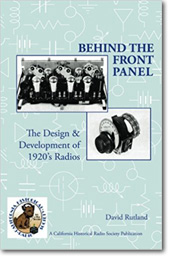 Behind the Front Panel: The Design and Development of 1920s Radios by David Rutland. 2nd Edition (2013)
Behind the Front Panel: The Design and Development of 1920s Radios by David Rutland. 2nd Edition (2013)
The title is about as accurate and descriptive as I've seen: the author discusses the technical development of radio sets—the kind the general public would have constructed or purchased, through the 1920s. He begins with crystal sets and ends the advent of AC tubes and tetrodes.
While a few actual makes and models are discussed (e.g. the early Grebe CR-13), it's really more about the conceptional evolution: so there's a discussion regeneration and the problems that came with it, which led to the TRF models and the problems with neutralizing the capacitance in those triodes (this is a large portion of the book); he discusses audio amplification, reflex circuits, the early superhets, and of course, the often painful development of one-knob tuning.
Rutland was (is?) an electrical engineer who can explain technical concepts in a clear manner: something I see too rarely and appreciate it here. This is the first time I've read an explanation of how a tube oscillates when there's too much feedback in a regeneration circuit; it's the first good explanation I've seen of how and why grid-leak detector works; and so forth. People who are already very familiar with the technical side of radio probably won't get much out of it, but those of us lower on the knowledge ladder will definitely benefit.
There isn't much here in terms of actual makes and models: other than a few examples, it's mostly about the concepts. If you want to know that a particular Atwater-Kent introduced such-and-such a feature, or whether Charles Freshman's "Masterpiece" really was, you'd be better off reading Alan Douglas's Radio Manufacturers of the 1920s books. But if you want to understand what a reflex circuit is, this book ought to be first on your list.
My copy is the 2nd edition but I believe it's only a reprint of the original from 1994.
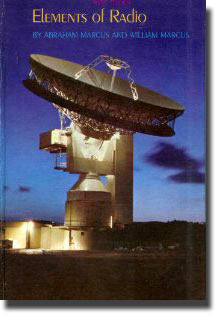 Elements of Radio by Abraham Marcus & William Marcus. 6th Edition, 1973.
Elements of Radio by Abraham Marcus & William Marcus. 6th Edition, 1973.
This was designed as a textbook for a year-long vocational school course on radio, and include quizzes and lab experiments.
This is a very good companion piece to Elements of Radio Servicing by Marcus & Levy. Whereas the other books are hard-targeted on repair, this is a bit more open ended and general on radio topics.
They approach it by beginning with the bare minimum: an antenna, a ground connection, a detector and some kind of speaker. They discuss how and why things work. Then they improve it a little by adding coils for transfer coupling. Then they add a capacitor to make a tank circuit. Then they change the crystal detector to a rectifier tube. They slowly keep adding and building and making the radio more complex but better performing, step by step, explaining the hows and whys along the way.
The nice thing about this book is that it really digs into the subject in depth, whereas most other books don't have the time or scope to do it. Even with Elements of Radio Servicing, the focus is on why things are there rather than how they got there. The end result is the same, but a person who reads this book may get a better understanding of what the engineers were thinking when they designed these rigs.
The bad part of the book is that even the 1974 edition is very dated. If you want to do the lab experiements yourself, you're going to be hard pressed to find some of the equipment (like old telephone headsets) that were taken for granted then.
I'm still working my way through the book so I can't comment on how they handle solid-state electronics. The bulk of the book (as is the last edition of Elements of Radio Servicing) focused primarily on vacuum-tube technology. So if you want to learn to work on old hollow-state radios, I think it's a must-have. If you want to work on transistor-era radios, I don't know how helpful it will be, but it certainly won't hurt.
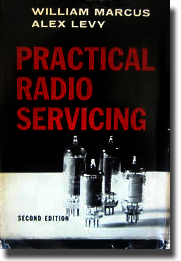 Elements of Radio Servicing by William Marcus & Alex Levy. 1st Edition, 1947.
Elements of Radio Servicing by William Marcus & Alex Levy. 1st Edition, 1947.Practical Radio Servicing by William Marcus & Alex Levy. 2nd Edition, 1956-1963.
Elements of Radio Servicing by William Marcus & Alex Levy. 3rd Edition, 1967.
I'm treating these all in one section since they go together.
Marcus & Levy were educators, and these are textbooks aimed at teaching vocational students how to repair radios as a profession, so their focus is on repairing the commercial-broadcast AM and FM radios that people would be most likely to bring into a shop for repair (including car radios). ham gear, military surplus sets and CB are not covered. Neither are the very old TRF, one-tube regenerators, and other pre-superhet rigs that were popular in the 20s but typically built from kits or plans.
Their approach is to take a garden variety superhetrodyne radio, break it down into separate stages (e.g. power supply, mixer, IF amp, final audio amp) and discuss how it works, what goes wrong and how to fix it. Typically they use a generic radio design for teaching, and suppliment with actual radio models to explain how various manufacturers use different approaches to solve a given problem.
So which edition is the most desirable? In my opinion, they rank in reverse order of publication: the third edition is best, followed by Practical, and the first edition from 1947 is the least.
That's because with each later publication you get the advantage of newer technology. The 1947 edition only discusses pre-war AM sets with transformer power supplies and 6-volt octal tubes. While a lot of the information is useful, it's still very limited. Practical begins with the standard transformerless AC/DC set, aka the All-American-5, which is much more common and a good set to learn on. It discusses both the older chassis-mount and newer printed-circuit models. And it also includes chapters on transistor radios and FM radios (albiet mostly tube jobs). It is, in my opinion, head-and-shoulders above the original 1947 edition.
The final 3rd edition (from 1967) isn't such a big step beyond Practical, but it's still a bit more advanced. It's also a little better illustrated, and wheras Practical has the rectangular format of a normal book, Elements (3rd edition) is square and more like a textbook; the pages lay a bit more flat (mine does, anyway), and the illustrations are more often present normally, rather than turned 90° to fit on a page, so you're not always turning the book sideways to read a schematic and then turning it back to read the text. Little things like that are nice.
The 1947 first edition is freely available on the internet, so don't buy a digital copy unless you get some kind of deal. Find it at Antique Radios. For the others, keep an eye out at used bookstores. Some public libraries still have the later editions as well.
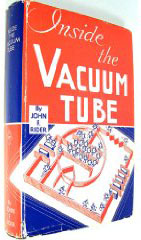 Inside the Vacuum Tube by John Francis Rider. 1st Edition, 1945.
Inside the Vacuum Tube by John Francis Rider. 1st Edition, 1945.
This is a basic texbook to introduce vacuum tubes. The book begins assuming almost no prior knowledge, so it explains quite a lot about the nature of electrons and electrical current, which sets up the concept of space charge and attraction, which leads into how the cathode and plate work, then how the grid affects the current flow, and so on.
I found that things got hairy when he moved into tetrodes and pentodes, but still very clear and readable. It's also one of those books which tries to explain how things work without advanced math; so instead of formulae, you learn how to read the standard graphs and follow load lines, which is useful because vacuum tube data sheets typically print these charts.
It's an excellent book if you want to get a good look at how tubes work and why, rather than that they simply do.
This is freely available on the internet, so don't buy a digital copy unless you get some kind of deal. Find it at Antique Radios.
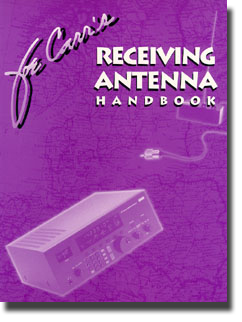 Joe Carr's Receiving Antenna Handbook by Joseph J. Carr. 1993.
Joe Carr's Receiving Antenna Handbook by Joseph J. Carr. 1993.
Even with "reciprocity," the needs of receiving and transmitting antennas aren't quite the same. If you're transmitting, you're pushing full watts, maybe tens, perhaps hundreds of watts out. When receiving, you're dealing with mili and microwatts.
Carr writes, as he states, from "the receiving point of view" which is a little different than the transmitting POV. But it's not that much different. Primarily this antenna book covers all the things that any other good antenna book covers, so if you're looking for something really new and different, I don't think you're going to find it here.
On the plus side, and it's a big plus, Joe Carr is a very good writer and this book the best on the subject that I've seen so far—at least from a beginner's standpoint (and that would be me). It's technical but not filled with advanced math. He's able to describe what's happening without a thick layer of engineering gobbledegook. I think this is a great first antenna book, and then you can go on to the ARRL Antenna Book for the heavy lifting.
I am a little bit disappointed, which is why I only gave this four stars instead of five on Amazon.com. My interest is listening, not transmitting, so I was hoping this would really hone in on how to maximize reception, and I didn't really see that. Of course, the problem with antenna installation is that there are so many variables—where you are, what you're trying to receive, and what the local conditions are—that nobody could provide what I was looking for. Still, considering this book is the receiving antenna handbook, I did expect a little more emphasis, somehow, on the receiving part of things and I just don't see it here.
I would not hesitate to recommend this book to anyone who's just starting out and wants to know about antennas, regardless of your POV. Carr's an excellent writer and this book is worth the money.
Modern Radio Servicing by Alfred A. Ghirardi. 1935,
Radio Servicing Course by Alfred A. Ghirardi and Bertram M. Freed. 1932
Modern being the early 1930s. I've got the April 1943 fifth printing, and they've updated the appendices for then-current tube data and basing, but I don't think anything else was changed.
This is a huge book. Even without the tube data it's over 1,200 pages. The book is divided into two major sections: the first covers test equipment (meters, tube testers, analyzers and signal generators); the second with how to troubleshoot and repair radios of then-current types, including both TRFs and superhets, and deals with home sets, car radios and marine units. But again, this is current as of the mid-1930s.
Radio Servicing Course is from a few years earlier and is a much slimmer volume, but what I say below applies to both.
Ghirardi was a long-time contributor to the magazine Radio News, and he's a very good writer. While it lacks the informal ease of Frye's Basic Radio Course, it is written in a clean, straightforward manner that reads easily.
I like these books because I find them readable and interesting, but of limited value because of their age. If you work on radios up to this era, either are probably fine (though Modern would be better because it's more extensive), but they're both too early to be useful for many radios. The descriptions of test equipment are interesting because he goes into real detail on how things work, how to build your own, and the differences between popular commercial models; but again, the state of the art then was primarily VOMs at 1,000Ω/V DC, emission-only tube testers, and so forth.
I would not recommend these to a beginner as an introduction. I would suggest them to someone who's already been around a bit and wants to be immersed in pre-octal era radio technology.
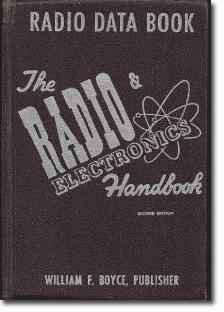 Radio and Electronics Handbook (aka Radio Data Book) by William F. Boyce and Joseph J. Roche. 2nd printing, 1952.
Radio and Electronics Handbook (aka Radio Data Book) by William F. Boyce and Joseph J. Roche. 2nd printing, 1952.
One of those books that's supposed to be a small format "handbook" so it's the size of a paperback; but at nearly 900 pages it's so thick it's anything but. I think the book would be a lot better if it were in a larger format and thinner.
This is really two books in one. The first two-thirds is basic information on all things electronic, beginning with the fundamentals and ending with test, measurement and aligment of televison. If you're familiar with the old ARRL Handbooks, this is very similar. Lots of great information but it's very dry.
The rest of the book is reference data of all kinds: common formulas, trig and log tables, how to read various resistor and capacitor codes, cable and lead colors, pilot lamp data, and a big section on vacuum tube specs.
Most of this is stuff you can find on the internet (e.g. vacuum tube specs), but some, like transformer lead color schemes, are much more difficult to find. Here it's all packed into this one book. I wouldn't pay a lot for it, but if you can find an inexpensive copy, it would be worth having.
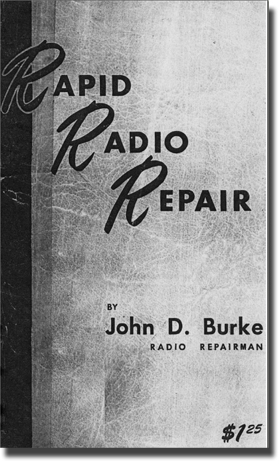 Rapid Radio Repair by John D. Burke. 1950.
Rapid Radio Repair by John D. Burke. 1950.
This self-published book is rare and very hard to find. Someone finally got a copy and scanned it into PDF format, which is how I got it.
Not to be confused with another book of the same title (directly below); author Burke claimed that he was unhappy with radio fault-diagnosis tutorials given in popular magazines of the day, and he wrote a letter to Radio & TV News (Sept. 1949) telling his objections. Burke was a working professional repairman, and his job was diagnose a fault as quickly as possible in order to effect the needed repair and get the radio set off his bench and back to the customer. The more radios he could repair in given amount of time, the more repair revenue came in. Customers also wanted their radios back as soon as possible.
The magazine articles often took a methodical, linear step approach to diagnosing fault, such as beginning at the speaker and working backward through each stage, or vice-versa. That sort of thing worked in school for teaching students, but it was too slow and inefficient for volume radio repair work.
Burke said that after his letter was published, he received a letter from a reader asking him for advice on real-world, practical radio service techniques. What started out as Burke's reply ballooned into a small book on the subject, which became Rapid Radio Repair.
Burke isn't a professional writer and it shows—the book is a bit loosely organized, but it's conversationally written, lively and easy to digest. It does two things simultaneously: one is that it advocates signal-tracing as a method for locating faults, and the other is a collection of "best practices" on how to do it quickly.
I wanted it because I'd acquired a Hickock Trace-o-Meter and this book discusses how to use it. Burke likes that instrument and discusses its faults and virtues (including some comments on how to improve it). At one point he says he doesn't like units with magic eyes, but I assume most of what he discusses could be done with other tracers like the Chanalyst anyway.The book is meant for people who know something about radio and how it works (i.e. the readers of Radio & TV News magazine), but are not professionals. I wouldn't recommend it for beginners; but for anyone who's spent some time working on old radios, there are a lot of food for thought.
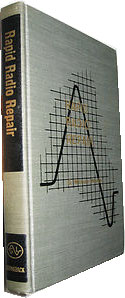 Rapid Radio Repair by G. Warren Heath. 1959.
Rapid Radio Repair by G. Warren Heath. 1959.
Not to be confused with a book of the same name by John D. Burke (above). This is a completely different kind of book.
There appears to be at least a couple editions of this book; there's mine from 1959, and another from the early 1970s that I haven't seen. So my comments only pertain to the 1959 edition.
This reads as shop notes on various subjects. There are four major sections: receivers, techniques, servicing and charts. Within each section, he takes topics alphabetically and offers some notes on the subject; the notes may be brief (the entry for AC receivers is brief) or relatively long (e.g. transistor receivers). Here's an example of the content and writing style. This comes from the Servicing section, Page 149:
Growl
Symptoms: Growl heard in the speaker
Service: This condition is usually caused by a defective grid return resistor in the output stage. Also check the rectifier tube for a gassy condition.Heterodyne on all stations—transistor receivers
Symptoms: Heterodyne beat note heard on all stations.
Service: This condition can be caused by a defective IF transistor, a weak battery, or misalignment as well as a defective filter capacitor (including AGC filter) or IF neutralizing capactior. In the latter case, replace by a zero-temperature-coefficient unit. Check to make sure that the antenna coil core isn't cracked or broken.Hiss—AM receivers
Symptoms: A loud hissing noise heard in the audio output.
Service: Hissing due to random noise is normal, especially when the signal is weak or absent. However, this condition can be caused by a poor antenna. This applies primarily to older receviers operating on an external antenna, especially those that are used in fringe areas. In addition, hissing can be produced by superregeneration, due to a defective grid resistor in the oscillator circuit.
It would not be good as a way to introduction to radio repair, but it's a great suppliment.
I've seen this for all sorts of different prices from various sellers; it's not difficult to find, so it pays to shop around.
Television & Radio Repairing by John Markus. 1st Ed. 1953
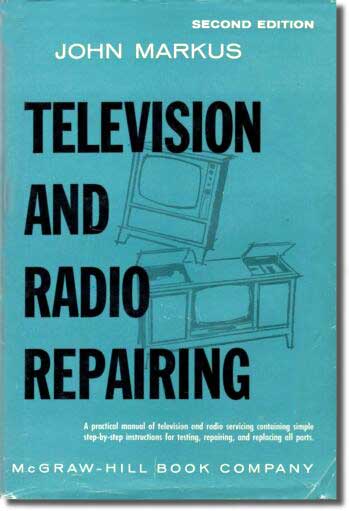 For awhile I thought John Markus was related to Abraham and William Marcus of the "Elements of Radio . . ." books. Then I finally realized the spelling was different, and this is a different book entirely.
For awhile I thought John Markus was related to Abraham and William Marcus of the "Elements of Radio . . ." books. Then I finally realized the spelling was different, and this is a different book entirely.
I really like this book, but it's an unusual one. It's both a tutorial on how to repair consumer electronics (chapters include TV, radio, phonos, speakers, and cabinets), and how to run a business doing it. Unlike the other learn-to-service-radio books here, this one is a bit light on how radios work and how, say, different AVC circuits work, but goes into more depth on components. Carbon resistors gets an entire chapter, as do wire-wounds, controls and switches, condensors (aka capacitors), coils and transformers, and of course tubes. The book discusses how they work, they various different types of each, and when and how they're used. Some of the information is the same, but it's a different approach.
Because this book is also about the business side of things, you get a lot of information on how jobbers work, how much and what kind of components you want to stock in inventory, how to treat customers, how to charge for parts and labor, and so forth. Most of this is obsolete now, but it can still be interesting reading if you're interested in history.
Yet some of it is still valid. If I had any room, I'd build the service bench using the plans provided on page 33 (of my first edition).
I think this book goes nicely with the Marcus & Levy books: those get deep into how the radio works, this gets more into the component hardware side of it. I would definitely not recommend it for TV, at least not by itself. As with radio, it sketches out how TV works, but you're really better off finding a full, dedicated volume on TV repair and use this for component level, practical knowledge.
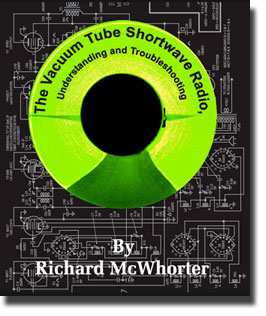 The Vacuum Tube Shortwave Radio: Understanding and Troubleshooting by Richard McWhorter. 1st Ed. 2007
The Vacuum Tube Shortwave Radio: Understanding and Troubleshooting by Richard McWhorter. 1st Ed. 2007
It looks like a PDF copy of a traditionally printed book. I don't know the background behind it, but you can get this PDF directly from the author at www.richardmcwhorter.com for free!
The irony is that this is a book well worth paying for. In a way it's a companion piece to his All American Five book (see above). But whereas the All American Five Radio is very short (92 pages), this one is 212 pages, and it looks, feels and seems much more complete. The All American Five looks at one specific radio as an example, this one uses various models as examples.
This book really shines in two areas. First is that it's devoted to boat anchors, those huge, metal-clad multi-band communications receivers like my National and Hallicrafters, which are more complicated than the AM-only table radios that most repair guides concentrate on. And even if you don't have a traditional boat anchor, extra shortwave bands were a common luxury feature on many "standard" radios. SW bands went in and out of vogue numerous times over the years.
The other is this book goes heavily into troubleshooting, which is extremely useful whether you're working on a hardcore boat anchor, a regular table radio with a couple of extra SW bands, or even an AA5.
Even though it's free and it's a PDF, the whole thing looks professionally done. It's clean, well-written, nicely illustrated, and well done all the way around. Highly recommended.
McWhorter also has a YouTube channel with videos about radios, repair and related subjects.
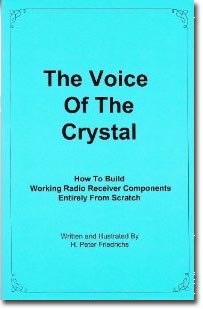
I've told this story elsewhere—I got interested in radios when I was little and The Old Man and I made a crystal set for a school project. My dad was particularly fond of crystal radios and the idea that you could get radio broadcasts for "nothing" (i.e. without batteries or wall power). Crystal radios are lean enough that they run off the electricity from the radio waves themselves.
The Voice of the Cyristal isn't just another "let's make a crystal radio!" book. Friedrichs is fascinated by crystal radios, but he's also very much a scratch-builder; most people who build crystal sets probably wind their own coils: Friedrichs makes his own cat's whisker detectors. He makes his own capacitors. He makes his own high-Z headphones. He does it with commonly available products, using wood and metal-working skills that an average person probably has or can reasonably acquire. I read this book and thought that even I could probably make these things.
The real twist of it is that his projects don't end up looking like junk-box jury rigs; they're beautiful. Check out the photo gallery on the author's website. They look like late-19th century lab equipment, the sort of thing you that Marconi or Tesla might have used.
The book is very well written. It tries to explain the basic principles of radio and how each electrical component works, and then how to make the component (like a capacitor) from scratch. Friedrichs is an experimenter and each item is presented as both a how-to and what-if; he never assumes that what he's doing is a perfect solution, but more as an example of what could be done.
Highly recommended if you're interested at all in crystal sets; and recommended in general simply because it's an interesting read.
Instruments of Amplification is the natural sequel to The Voice of the Crystal.
